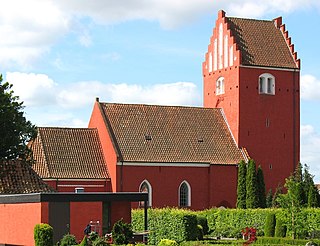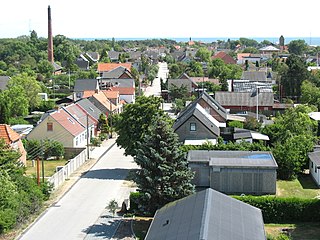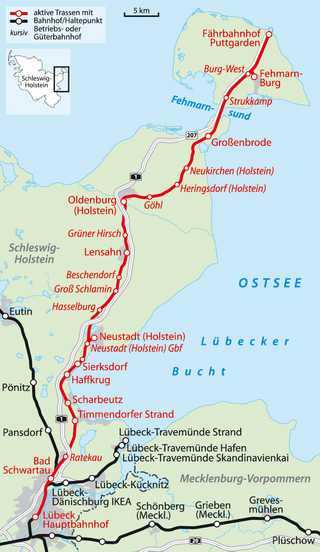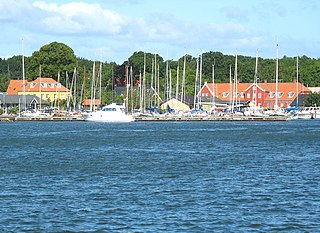
Maribo is a town in Lolland Municipality in Region Sjælland on the island of Lolland in south Denmark. It was the municipal seat of the former Maribo Municipality, until 1 January 2007, and then it became the seat of the current Lolland Municipality.

Nørre Alslev is a town with a population of 2,369 on the northern end of the island of Falster in south Denmark. It belongs to Guldborgsund municipality in Region Sjælland.

Nykøbing Falster is a southern Danish city, seat of the Guldborgsund kommune. It belongs to Region Sjælland. The city lies on Falster, connected by the 295-metre-long (323 yd) Frederick IX Bridge over the Guldborgsund waterway to the island of Lolland. The town has a population of 16,927. Including the satellite town Sundby on the Lolland side, with a population of 3,178 the total population is 20,105.

Nakskov is a town in south Denmark. It is situated in Lolland municipality in Region Sjælland on the western coast of the island of Lolland. The town has a population of 12,456. To the west is Nakskov Fjord, an inlet from the Langeland Belt (Langelandsbælt) that runs between the islands of Lolland and Langeland. Nakskov Fjord is a wildlife reserve, known for its bird life.

Falster is an island in south-eastern Denmark with an area of 486.2 km2 (187.7 sq mi) and 43,398 inhabitants as of 1 January 2010. Located in the Kattegat, Belts and Sound area, it is part of Region Zealand and is administered by Guldborgsund Municipality. Falster includes Denmark's southernmost point, Gedser Odde, near Gedser.

Lolland Municipality is a kommune on the island of Lolland in the Region Sjælland of Denmark. According to Municipal And Regional Key Figures (www.noegletal.dk) it covers a total area of 885.40 km² and has a population of 39,921. The western part of Guldborgsund Municipality, the southernmost in Denmark, occupies the eastern part of the island (Østlolland).

Guldborgsund is the strait between the Danish islands of Lolland and Falster. It connects Smålandsfarvandet in the north with the Bay of Mecklenburg in the south. The strait is about 30 kilometers long; its breadth varies from 150 meters at Guldborg to 6 kilometer south of Nykøbing Falster. It is navigable for craft of up to 6 metres draught in its northern part and is used for commercial traffic to Nykøbing Falster. The southern part is much shallower with a minimum depth of approximately 2 metres, and can only be used by yachts and other small craft.

The Danish straits are the straits connecting the Baltic Sea to the North Sea through the Kattegat and Skagerrak. Historically, the Danish straits were internal waterways of Denmark; however, following territorial losses, Øresund and Fehmarn Belt are now shared with Sweden and Germany, while the Great Belt and the Little Belt have remained Danish territorial waters. The Copenhagen Convention of 1857 made all the Danish straits open to commercial shipping. The straits have generally been regarded as an international waterway.

The Fehmarn Belt fixed link or Fehmarn Belt tunnel is an under-construction immersed tunnel, which will connect the Danish island of Lolland with the German island of Fehmarn, crossing the 18-kilometre-wide (11 mi) Fehmarn Belt in the Baltic Sea.

The Guldborgsund bridge spans the northern end of the Guldborgsund, between the islands of Lolland and Falster in Denmark. The bridge consists of two steel arched spans with a 30m central opening section having two rising bascules. It was built between 1933 and 1934, is 180m long and 7m wide, carrying two road carriageways and was officially opened by Prince Axel of Denmark on 6 October 1934.

Gedser is a town at the southern tip of the Danish island of Falster in the Guldborgsund Municipality in Sjælland region. It is the southernmost town in Denmark, and also the southernmost point of Scandinavia and the Nordic countries. The town has a population of 659. It is an important port town on the Baltic Sea.

The Vogelfluglinie (German) or Fugleflugtslinjen (Danish) is a transport corridor between Copenhagen, Denmark, and Hamburg, Germany.

Middelaldercentret is an experimental living history archaeological open-air museum in Denmark, which depicts the middle ages in the Denmark of the late 14th and early 15th centuries. It is located in Sundby Lolland, some 4 km northwest of the centre of Nykøbing Falster on the waterfront of Guldborgsund.

Lolland is the fourth largest island of Denmark, with an area of 1,243 km2 (480 sq mi). Located in the Kattegat, Belts and Sund area, it is part of Region Sjælland. As of 1 January 2022, it has 57,618 inhabitants. Lolland is closely connected to the island of Falster to its east. The locality of Sundby forms a cross-island urban area with Nykøbing Falster, the largest conurbation partially on Lolland. The most populated settlement on Lolland proper is Nakskov.

The Lübeck–Puttgarden railway is part of the international Vogelfluglinie between Germany and Denmark and connects Lübeck with Puttgarden on the Baltic Sea island of Fehmarn in the German state of Schleswig-Holstein. The line is now closed north of Neustadt for the construction of the Fehmarn Belt Fixed Link.

Guldborg is a fishing village spanning the islands of Falster and Lolland in Denmark. It belongs to Guldborgsund Municipality, in Region Zealand. In 2023 the village had a population of 530, with about 500 living on the Lolland side. The village is located at the narrowest point between the two islands where Guldborg Bridge crosses Guldborgsund Sound.

The South Line is a government-owned railway line in Denmark. Technically, the line connects Ringsted with Nykøbing Falster, from which it branches to Gedser and Rødbyhavn. In practice, Ringsted is not the terminal station, so the line is often said to continue to Copenhagen.

Danish national road 9 is part of the Danish national road network. It runs between Odense on Funen and Nykøbing Falster on Falster by way of Svendborg, Tåsinge, Siø and Langeland, and involves a ferry crossing between Langeland and Lolland.
























